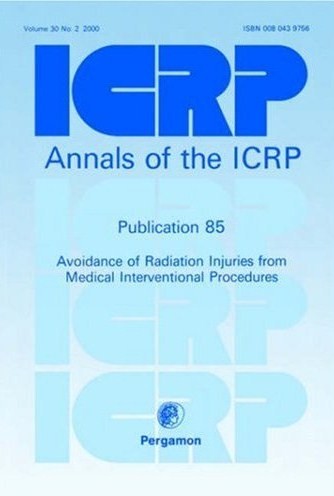ICRP Publication 85
Avoidance of Radiation Injuries from Medical Interventional Procedures
Recommended citation
ICRP, 2000. Avoidance of Radiation Injuries from Medical Interventional Procedures. ICRP Publication 85. Ann. ICRP 30 (2).
Abstract - Interventional radiology (fluoroscopically-guided) techniques are being used by an increasing number of clinicians not adequately trained in radiation safety or radiobiology. Many of these interventionists are not aware of the potential for injury from these procedures or the simple methods for decreasing their incidence. Many patients are not being counselled on the radiation risks, nor followed up when radiation doses from difficult procedures may lead to injury. Some patients are suffering radiation-induced skin injuries and younger patients may face an increased risk of future cancer. Interventionists are having their practice limited or suffering injury, and are exposing their staff to high doses.
In some interventional procedures, skin doses to patients approach those experienced in some cancer radiotherapy fractions. Radiation-induced skin injuries are occurring in patients due to the use of inappropriate equipment and, more often, poor operational technique. Injuries to physicians and staff performing interventional procedures have also been observed. Acute radiation doses (to patients) may cause erythema at 2 Gy, cataract at 2 Gy, permanent epilation at 7 Gy, and delayed skin necrosis at 12 Gy. Protracted (occupational) exposures to the eye may cause cataract at 4 Gy if the dose is received in less than 3 months, at 5.5 Gy if received over a period exceeding 3 months.
Practical actions to control dose to the patient and to the staff are listed. The absorbed dose to the patient in the area of skin that receives the maximum dose is of priority concern. Each local clinical protocol should include, for each type of interventional procedure, a statement on the cumulative skin doses and skin sites associated with the various parts of the procedure. Interventionists should be trained to use information on skin dose and on practical techniques to control dose. Maximum cumulative absorbed doses that appear to approach or exceed 1 Gy (for procedures that may be repeated) or 3 Gy (for any procedure) should be recorded in the patient record, and there should be a patient follow-up procedure for such cases. Patients should be counselled if there is a significant risk of radiation-induced injury, and the patient’s personal physician should be informed of the possibility of radiation effects. Training in radiological protection for patients and staff should be an integral part of the education for those using interventional techniques. All interventionists should audit and review the outcomes of their procedures for radiation injury. Risks and benefits, including radiation risks, should be taken into account when new interventional techniques are introduced.
A concluding list of recommendations is given. Annexes list procedures, patient and staff doses, a sample local clinical protocol, dose quantities used, and a procurement checklist.
ICRP, 2000. Avoidance of Radiation Injuries from Medical Interventional Procedures. ICRP Publication 85. Ann. ICRP 30 (2).
Abstract - Interventional radiology (fluoroscopically-guided) techniques are being used by an increasing number of clinicians not adequately trained in radiation safety or radiobiology. Many of these interventionists are not aware of the potential for injury from these procedures or the simple methods for decreasing their incidence. Many patients are not being counselled on the radiation risks, nor followed up when radiation doses from difficult procedures may lead to injury. Some patients are suffering radiation-induced skin injuries and younger patients may face an increased risk of future cancer. Interventionists are having their practice limited or suffering injury, and are exposing their staff to high doses.
In some interventional procedures, skin doses to patients approach those experienced in some cancer radiotherapy fractions. Radiation-induced skin injuries are occurring in patients due to the use of inappropriate equipment and, more often, poor operational technique. Injuries to physicians and staff performing interventional procedures have also been observed. Acute radiation doses (to patients) may cause erythema at 2 Gy, cataract at 2 Gy, permanent epilation at 7 Gy, and delayed skin necrosis at 12 Gy. Protracted (occupational) exposures to the eye may cause cataract at 4 Gy if the dose is received in less than 3 months, at 5.5 Gy if received over a period exceeding 3 months.
Practical actions to control dose to the patient and to the staff are listed. The absorbed dose to the patient in the area of skin that receives the maximum dose is of priority concern. Each local clinical protocol should include, for each type of interventional procedure, a statement on the cumulative skin doses and skin sites associated with the various parts of the procedure. Interventionists should be trained to use information on skin dose and on practical techniques to control dose. Maximum cumulative absorbed doses that appear to approach or exceed 1 Gy (for procedures that may be repeated) or 3 Gy (for any procedure) should be recorded in the patient record, and there should be a patient follow-up procedure for such cases. Patients should be counselled if there is a significant risk of radiation-induced injury, and the patient’s personal physician should be informed of the possibility of radiation effects. Training in radiological protection for patients and staff should be an integral part of the education for those using interventional techniques. All interventionists should audit and review the outcomes of their procedures for radiation injury. Risks and benefits, including radiation risks, should be taken into account when new interventional techniques are introduced.
A concluding list of recommendations is given. Annexes list procedures, patient and staff doses, a sample local clinical protocol, dose quantities used, and a procurement checklist.
